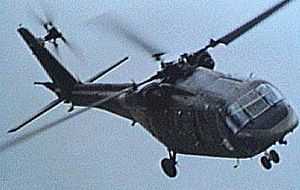Boeing Vertol YUH-61
| YUH-61 | |
|---|---|
 | |
| Boeing Vertol YUH-61A | |
| Role | Utility transport helicopter |
| Manufacturer | Boeing Vertol |
| First flight | 29 November 1974 |
| Status | Program terminated |
| Primary user | United States Army |
| Number built | 3 |
|
| |
The Boeing Vertol YUH-61 (company designation Model 179), was a twin turbine-engined, medium-lift, military assault/utility helicopter. The YUH-61 was the runner-up in the United States Army Utility Tactical Transport Aircraft System (UTTAS) competition in the early 1970s to replace the Bell UH-1 Iroquois helicopter. At the end of the flyoff program, Sikorsky Aircraft was awarded a contract to develop and build its UH-60A entry.
History
Under a contract awarded in August 1972, Boeing Vertol designed and delivered three prototypes to compete UTTAS program.[1] When Boeing Vertol failed to win the Army competition, it pinned its hope on winning civil orders and the US Navy's LAMPS III program. In the end, a variant of the Sikorsky design, the SH-60B, won the Navy contract, and the civil orders received were canceled.[1]
Three aircraft were built and a further two were cancelled and not completed. An attack helicopter design, using the YUH-61's dynamic system was proposed for the Advanced Attack Helicopter competition, but did not make the downselect that resulted in the Bell YAH-63 and Hughes YAH-64 being built. The Boeing Vertol AAH design was unique in that the crew were seated in a laterally staggered tandem configuration.[2]
Design
The YUH-61 was designed to meet the UTTAS requirements for improved reliability, survivability and lower life-cycle costs, resulting in features such as dual-engines with improved hot and high altitude performance, and a modular design (reduced maintenance footprint); run-dry gearboxes; ballistically tolerant, redundant subsystems (hydraulic, electrical and flight controls); crashworthy crew (armored) and troop seats; dual-stage oleo main landing gear; ballistically tolerant, crashworthy main structure; quieter, more robust main and tail rotor systems; and a ballistically tolerant, crashworthy fuel system.[3]
Transport aboard the C-130 limited the UTTAS cabin height and length.[4] This also resulted in the main rotor being mounted very close to the cabin roof.
While Sikorsky chose a fully articulated rotor head with elastomeric bearings, Boeing Vertol chose a rigid main rotor design, based upon technology supplied by MBB, which was partnered with Boeing Vertol at the time.[5] Boeing Vertol also selected to use a tricycle landing gear and a pusher tail rotor, as opposed to the tail wheel configuration and canted tractor tail rotor that Sikorsky chose.
Variants
- Model 237: naval version of the YUH-61 for the USN's LAMPS II competition (ship-based multi-purpose helicopter) and lost out to Sikorsky SH-60 Seahawk; no models built
- Model 179: civilian 14–20 passenger utility helicopter later canceled; 1 model built
Survivors
Two of the three aircraft (73-21656 and 73-21658) built are preserved at the United States Army Aviation Museum in Fort Rucker, Alabama.
Specifications (YUH-61A)
Data from Modern Military Aircraft[1]
General characteristics
- Crew: Minimum 2 pilots
- Capacity: 14–20 passengers
- Length: 60 ft 8.5 in (18.504 m)
- Height: 15 ft 6 in (4.72 m)
- Empty weight: 9,750 lb (4,423 kg)
- Max takeoff weight: 17,700 lb (8,029 kg)
- Powerplant: 2 × General Electric T700 turboshaft engines, 1,536 hp (1,145 kW) each
- Main rotor diameter: 49 ft (15 m)
- Main rotor area: 1,885 sq ft (175.1 m2)
Performance
- Maximum speed: 155 kn; 286 km/h (178 mph)
See also
- US Helicopter Armament Subsystems
- Aircraft of comparable role, configuration and era
- Related lists
- List of helicopters
References
- ↑ 1.0 1.1 1.2 Gunston, Bill: The Illustrated Encyclopedia of the World's Modern Military Aircraft, page 205. Crescent Books, New York, NY USA, ca. 1978. ISBN 978-0-517-22477-9
- ↑ http://www.helis.com/h/bo_aah.jpg helis.com, Retrieved: June 14, 2011.
- ↑ Leoni 2007, pp. 42–48.
- ↑ Leoni 2007, pp. 39, 42–43.
- ↑ Leoni 2007
- Bibliography
- Leoni, Ray D. Black Hawk, The Story of a World Class Helicopter. American Institute of Aeronautics and Astronautics, 2007. ISBN 978-1-56347-918-2.
External links
| Wikimedia Commons has media related to Boeing Vertol YUH-61. |
- UTTAS program—YUH-61 origins
| ||||||||||
| ||||||||||||||||||||||||||||||||||
| ||||||||||||||||||||||